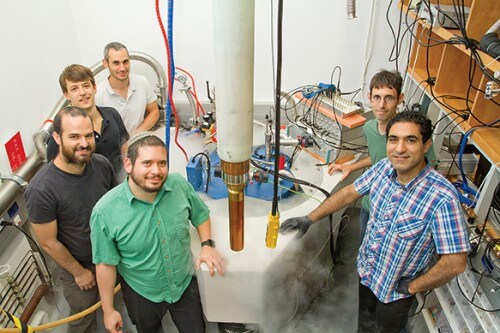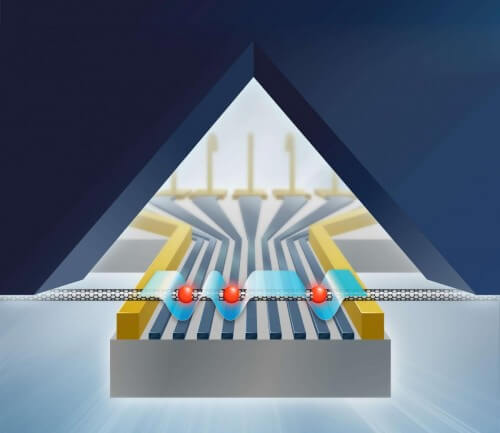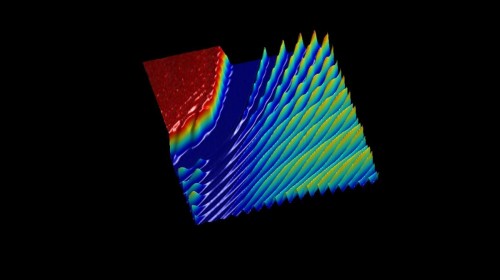Weizmann Institute scientists succeeded in creating an electron crystal ("Wigner crystal") consisting of two electrons

In 1934 the physicist Eugene Wigner published a surprising theoretical prediction: he claimed that under certain circumstances electrons may form a crystalline structure. The crystals we know are made of atoms located in an ordered lattice structure, which is a product of the forces of attraction between them. Electrons, on the other hand, find it difficult to manage in a stable and permanent place. These tiny particles, which are almost weightless, are mostly in constant motion. The negative charge they carry causes them to be rejected and distanced from each other. Wigner claimed that it is precisely this property - the mutual repulsion - that pushes the electrons to arrange themselves in a crystalline structure.
The simplest example of the phenomenon can exist when the electrons are placed in a one-dimensional structure - as beads on an imaginary wire. The mutual repulsion between them overcomes their tendency to move, forcing them to arrange themselves at equal intervals along the wire.
In order to create a "Wegener crystal" a system is required in which there is a strong repulsion between the electrons and themselves, but the interaction with other components in the system, which may interfere with the creation of the crystal, is minimal. Systems based on metals, for example, are out of the question, because electrons move relatively freely in a metallic material, and it has too many electrons to match the conditions required to create a "Wiger crystal". On the other hand, even introducing a small amount of electrons into an inert material does not create the desired result, because even a small concentration of defects, which exist in any of the known materials, will cause the electrons to be attracted to them, instead of interacting with each other.
Therefore, creating a Wigner crystal is a complicated task. Scientists looking for ways to create it have so far only discovered hints of its existence, but no one has been able to prove its existence directly. Now, about 80 years after Wigner's theoretical prediction, Dr. Shachel Ilani and research student Sharon Packer, from the Department of Condensed Matter Physics at the Weizmann Institute of Science, in collaboration with scientists from the USA, Italy and Denmark, have succeeded in creating a Wigner crystal consisting of two electrons - a kind of "The Wigner molecule".

For this purpose, the scientists chose a tiny and clean carbon nanotube, and injected two electrons into it. The carbon atoms from which the nanotube is built are tightly bound to each other, for the purpose of creating the stable structure, and therefore the two additional electrons only interact with each other. Measuring the energy levels of the system showed the scientists that it behaved as expected from a Wigner crystal: each of the electrons was located at a different end of the nanotube. After that, the scientists forcibly "squeezed" the electrons to one side of the nanotube, and discovered that despite the pressure exerted on them, the electrons maintain a distance from each other. "This behavior of the electrons in response to pressing indicates that the 'Wigner molecule' created is a product of the interactions between the two electrons, and does not result from the influence of the external environment," says Sharon Packer.
In addition to proving Wigner's theoretical prediction, Dr. Ilani says that the study, published in the scientific journal Nature Physics, is an important illustration that carbon nanotubes can be a unique physical system, allowing for the first time to control the properties of electrons in a controlled manner. "If we manage to expand our ability and control in a controlled way a large number of electrons along the carbon nanotubes, this will enable a new level of precise experiments in the solid state. Carbon nanotubes can be used as a clean laboratory for the study of basic phenomena in quantum mechanics, on a nanometric scale," says Dr. Ilani. This idea motivated his group to develop a new and efficient method for producing carbon nanotube devices. Their invention, which was recently published in the journal Nature Nanotechnology, makes it possible to create electrical devices from nanotubes that are more complex and clean than any that have been created to date, and in which the behavior of many electrons can be individually controlled.

Until now, the methods for manufacturing nanotube devices were based on the creation of two components at the same time: the growth of the nanotubes and the construction of the electrical circuit. Each of these tasks, alone, is extremely difficult, and the chance of producing a working device by accomplishing both is very small. "Our new method solves this fundamental problem by dividing the process into two separate steps," says research student Jonah Weissman. "On one chip we grow nanotubes, while we create the electric circuit on another chip. This separation makes it possible to produce each of these components perfectly. After that, we use tiny motors with nanometric precision to combine the two parts into one functional device." This is how it is now possible to create, for example, an electric circuit built from several nanotubes. "Our new manufacturing method leaves very little room for chance," says Dr. Ilani, "since we are able to verify that both the nanotube and the electrical circuit are perfect, even before their assembly into a functional device."
Using the new devices that will be produced, Dr. Ilani and his group members plan to reveal new and fascinating aspects of Wigner molecules that contain an increasingly large number of electrons - in the hope of gradually approaching a full quantum crystal. These devices also open up a wider range of new research possibilities: carbon nanotubes are crystals with unique electrical and mechanical properties, and the new system constitutes a unique laboratory for their investigation. "The ability to control so many degrees of freedom will allow us to perform experiments in the nano world that were impossible to imagine until now," concludes Dr. Ilani.
